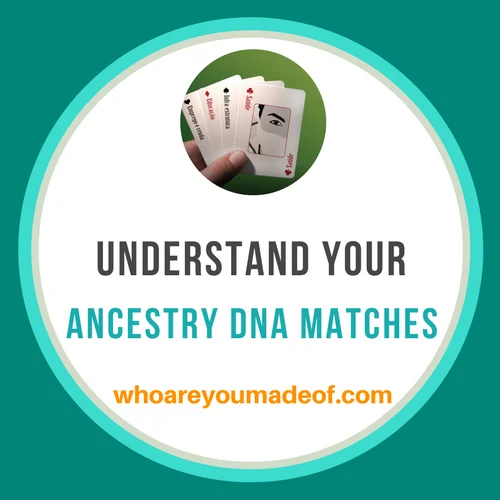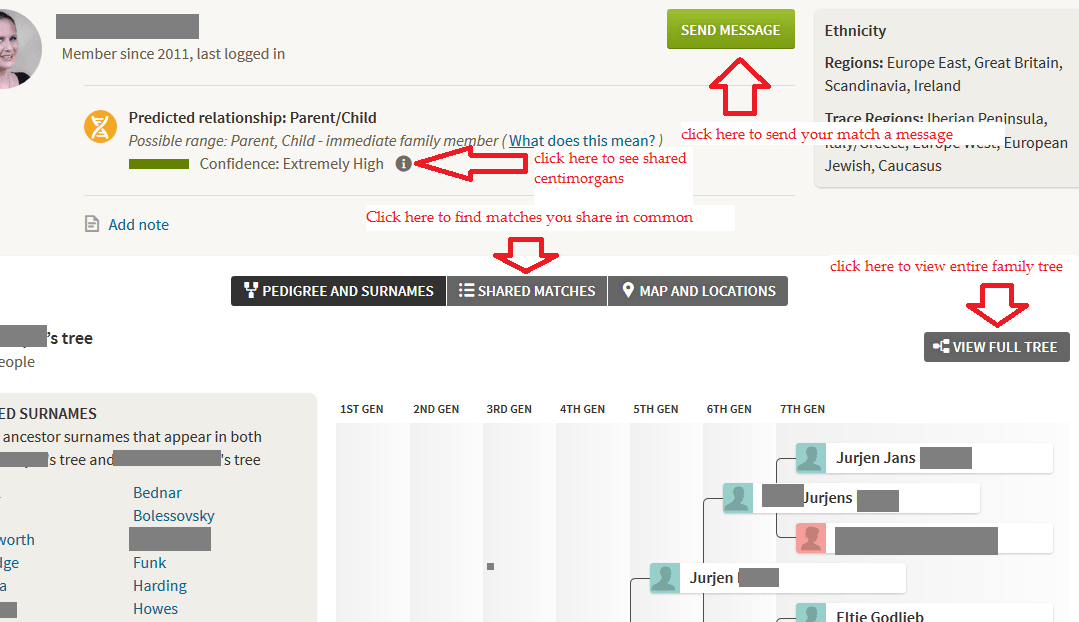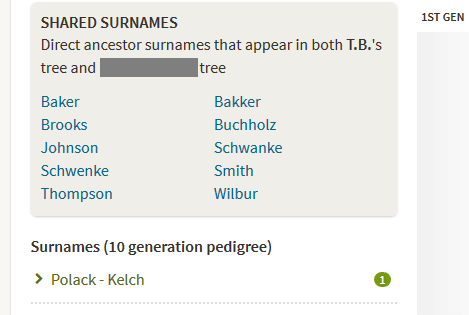There are many people who do the Ancestry DNA test that never realize that their test results come with a long list of DNA matches. This article will help you understand your Ancestry DNA matches.
Some who see the match list feel like it is overwhelming, and they don't know where to get started on understanding who these DNA relatives are to them.

In this post, you will learn:
- The basic anatomy of your match list
- Aspects of the DNA match profile
- How to figure out how your DNA matches are related to you
- How accurate the DNA match list is
I'm very glad that you are interested in getting to know your DNA match list better. There is so much to learn from it, and it is my favorite aspect of genetic genealogy DNA testing.
Pro tip: To get the most out of your DNA match list, learn how to attach your family tree to your DNA results.
Understand your DNA matches - the match list
Your DNA match list is organized by the estimated relationship type. The people who are listed first are your closest relatives (who have also done a DNA test), and those who are listed last are those who are most distantly related to you.
There are various way sort your match list, but I recommend viewing it as-is the first few times you check it out, just to orient yourself.
In the graphic below, you can a few different options for sorting your match list:

As you can see the from the graphic above, you can easily tell if your DNA match has a public family tree attached to their DNA results. A little tree icon will appear next to the "View Match" button, and it will tell you how many people are in their public family tree.
You can also see the relationship estimate right from the DNA match list, so you can decide if you want to click through and learn more about the match.
Even if a match doesn't have a public family tree attached to their DNA, you can still click through onto their match page and see if they have a tree that is public, but just isn't connected to their DNA.
Many times, they just haven't gotten around to attaching the tree to their DNA results. You can learn a lot this way.
Note: In order to see their family tree, you will have to have a subscription. You can use this link (I will get a small commission if you end up purchasing) to try a two week free trial: Ancestry Free Trial Thanks for your support, it really helps out.
If both you and your match have a public family tree attached to your DNA, you might have shared ancestor hints. If you do, they will look like this:

Aspects of the DNA match profile
To really get the most out of your DNA results, you should consider clicking the "View Match" button next to a few DNA matches on your list. In this section of the post, I'll take you through my profile as I show up for my DNA matches.
You should get a good idea of what you can learn from your own matches, and how they can help you explore your family's unique history.

How to know how your DNA matches are related to you
Ancestry divides relationships up into the following categories:
- Parent/Child
- Immediate Family
- Close Family
- 1st Cousin
- 2nd Cousin
- 3rd Cousin
- 4th Cousin
- Distant Cousin
Ancestry DNA accurately predicts some relationship types
People are in the Parent/Child category are almost 100% guaranteed to be either your parent or child. That is, unless you or a parent has an identical twin (rare).
People who are listed in the Immediate Family are usually full siblings. Half-siblings, full aunts, full uncles, grandparents, and other very close relatives will usually fall into the Close Family category.
Your DNA matches that are in a cousin category (i.e. 1st - 4th cousin, and more distant) are all related to you. That said, the exact relationship type becomes more difficult to accurately predict the more distant the relationship is.
That's because there is more overlap in the amount of DNA shared at these relationship distances.
For every relationship except for the Parent/Child and the Immediate Family category, you will have to use more traditional research methods to figure out the exact relationship.
Using the DNA match and amount of shared DNA as a clue to what type of relationship level is likely, you can compare family trees to figure out how you are related.
Basic ways to know how you are related
If both you and a DNA match have a public family tree, and you have a subscription, you will be able to view their family tree and see if you have any surnames in common.
If you have a surname in common, Ancestry will actually put it at the top of the tree, for you to view immediately. In some cases, you might have more than one surname in common, and you'll have to see if they are all common ancestors or some just a coincidence:

What if I don't know my family tree: DNA matches
It's common to find a DNA match that is not familiar with their family history. Sometimes, it's even a relatively close match that doesn't know their family tree. If you know your tree (or vice versa) you can use age and geography to help them figure out which line of your family they belong to.
Once, in my own family, I had a close cousin match pop up. She had grown up not knowing who her biological father was.
We were able to compare notes and determine that one of my mother's uncles was her biological father. The information that we had was where she was born, and where male members of my mother's family had lived during their lives.
We were able to narrow it down to two individuals. One was married when she was born, the other was single (and more close in age to her mother).
A paternity test with this man confirmed that he was her father within a week. A wonderful outcome for all.
You can also use other aspects of the DNA match profile in order to eliminate potential lines of a family. For example, most people show their major and trace ethnicities on their profile.
This can occasionally help you figure out which side of the family the person is on. If your dad has Greek or Italian, your mom doesn't, and your mystery match does, this could mean that the match is on your dad's side of the family.
This works best with very close relationships, since of course the more distant, the more chance they could have gotten the Greek or Italian from a different line of their family.
Calculating relationship based on shared centimorgans
If there is no extensive family tree to compare, another way to try to figure out how you might be related to your DNA match is to check to see how many centimorgans of DNA you share.
Some companies report a shared percentage of DNA; Ancestry DNA gives you a number of shared DNA segments, with the total number of centimorgans shared. Below, you can see a basic list of approximate ranges.
Ranges for Shared Centimorgan Calculator with all relationship possibilities:
- 2301-3900 cMs (Full sibling)
- 1301-2300 cMs (Half-sibling, Aunt, Uncle, Niece, Nephew, Double First Cousin, Grandparent, Grandchild)
- 575-1300 (First Cousin, Half-Aunt, Half-Uncle, Half-Niece, Half-Nephew, Great-grandparent, Grandniece, Grandnephew, First Cousin Once Removed)
- 215-650 (First Cousin Once Removed, Half First Cousin, Half Great Aunt, Half Great Uncle, Half Great Niece, Half Great Nephew, Second Cousin, First Cousin Twice Removed, ½ First Cousin Once Removed)
- 75-360 (Second Cousin, First Cousin Twice Removed, ½ First Cousin Once Removed, 2nd Cousin Once Removed, ½ Second Cousin)
- 30-215 cMs (2nd cousin Once Removed, ½ Second Cousin, First Cousin Three Times Removed, ½ First Cousin Twice Removed)
- 40-109 (Third cousins, Second Cousin Twice Removed, with a note that 10% of 3rd cousins will NOT show any shared centimorgans)
- 1-35 (Just one answer: This relationship could be as close as a 3rd cousin, and as distant as any 8th cousin.)
(I am in the process of compiling my own chart on this topic, I will switch it out in place of the above list once it's ready)
As you can see in this list, there is some overlap in most relationship possibilities. This is why you need to combine the shared DNA to first see which relationship types are likely, and then use more traditional methods, like comparing family trees, in order to figure out the exact relationship.
How accurate are the Ancestry DNA matches?
Generally speaking, the Ancestry DNA match list is exceptionally accurate. This means that if someone is on your DNA match list, it is extremely likely that they are related to you in some way.
It just might take a little detective work to figure out the exact relationship.
As the saying goes, "DNA doesn't lie". Sometimes our DNA doesn't tell us what we want to hear Sometimes our DNA uncovers long buried secrets about our family's true roots.
Sometimes our DNA helps us find long lost family. When we do "one of those" DNA tests, we have to be ready to learn whatever it is that our DNA wants to tell us.
Conclusion
I hope that this post has been helpful in showing you how to navigate your DNA match list, and the match profile. One of my favorite hobbies is to check for new DNA matches - I am a super nerd, I know. Try it, you might like it, too!
If you have any questions or comments about anything that I have mentioned here, please let me know in the comments.
Thank you for stopping by! I appreciate your visit 🙂


Sue
Saturday 11th of February 2023
This was very helpful, however I do have a question or 2... This is the info I have on an individual:
575-1300 (First Cousin, Half-Aunt, Half-Uncle, Half-Niece, Half-Nephew, Great-grandparent, Grandniece, Grandnephew, First Cousin Once Removed) 1. Does this mean we are 1st cousins through a half Aunt of Uncle? Don't understand Half Nephew, we share Great Grandparents? Grand neice, nephew??? First cousins once removed??? Not sure how to look at this info.
Thanks again
Gillian Clark
Wednesday 28th of April 2021
I am very grateful for your clear explanations of many aspects of the wonderful world of DNA. Very helpful in solving my many mysteries, I am a novice at the DNA game so am trying hard to get a handle on it all. Many thanks, I appreciate your help.
Mercedes
Friday 30th of April 2021
Thank you for your kind words, Gillian. I am so glad that you have found this information helpful!